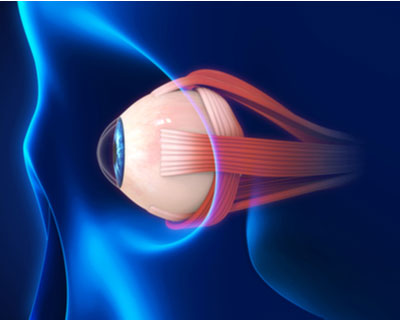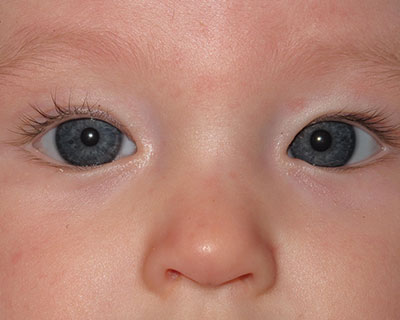What Is Strabismus (Crossed Eyes)?
Strabismus (crossed eyes) is a common eye condition among children. It is when the eyes are not lined up properly and they point in different directions (misaligned). One eye may look straight ahead while the other eye turns in, out, up, or down. The misalignment can shift from one eye to the other.
Six Eye Muscles Control Eye Movement
There are six muscles that attach to each eye and control its movement. One muscle moves the eye to the right, and one muscle moves the eye to the left. The other four muscles move the eye up, down, and at an angle. In order to focus on a single image, all six eye muscles in each eye must work together.

Strabismus affects vision because both eyes must aim at the same spot together to see properly. If someone’s eyes are lined up properly during childhood, vision should develop well. But if the eyes are not aligned, a condition called amblyopia can develop. This is when the misaligned eye has weaker vision.
What Causes Strabismus (Crossed Eyes)?
There are many reasons a child's eyes may point in different directions. One of the most common reasons is if the child is nearsighted or farsighted. If a child's vision is blurry because of nearsightedness or farsightedness, their eyes may have to strain to see clearly. This straining can cause a child's eyes to cross or drift apart. But when these kids wear glasses to improve their blurry vision, their eye alignment can improve too.
Other causes of strabismus include:
- premature birth
- neurological (brain-related) disorders
- Down syndrome
In many children, strabismus can happen without an obvious cause.
How Does Strabismus Affect Vision?
With normal vision, both eyes aim at the same spot. Our brain combines the two images from our eyes into a single, three-dimensional (3-D) image. This is how we can tell how near or far something is from us (called depth perception).
When one eye is out of alignment, each eye sends a different signal to the brain. In a young child, the brain learns to ignore the image of the misaligned eye. Instead, it sees only the image from the straight or better-seeing eye. As a result, depth perception may be affected.
Signs of Strabismus
You may notice that your child’s eyes look in different directions at the same time. You may also notice that your child closes one eye or tilts their head when looking at an object. This may be your child’s way of getting both eyes to work together—a sign of strabismus.
Your child’s pediatrician, school nurse, or teacher may notice these signs, too. If you think your child might have strabismus, visit a pediatric ophthalmologist for a complete eye exam.
Pseudostrabismus
When children are less than a year old, their eyes may look crossed when they really are not. This is called “pseudostrabismus.” It usually happens if the child has a wide, flat nose or a fold of skin at the inner eyelid.
A child can outgrow pseudostrabismus, but not strabismus.

Pseudostrabismus. Although the eyes appear misaligned, the light reflection is in the same place in both eyes.

A photograph showing an off-center reflection of light in left eye—a sign of strabismus.
Strabismus Types
There are three common types of strabismus.
- Esotropia is when one of the eyes crosses inward toward the nose.
- Exotropia is where one of the eyes drifts outward toward the ear.
- Hypertropia is when one eye points higher than the other eye.
Strabismus (Crossed Eyes) Treatment
Eyeglasses
Sometimes strabismus can be treated with eyeglasses. If a child's vision is blurry due to nearsightedness or farsightedness, they may have to strain to see clearly. This straining can make the eyes cross or drift apart. Glasses can correct the strabismus in these children.
Patching or eye drops
Sometimes an ophthalmologist may recommend patching or eye drops to strengthen a child's weaker eye. This can make it easier for the child to hold their eyes straight.
Sometimes surgery of the eye muscles is necessary to straighten the eyes.
Your child's ophthalmologists will help determine the best treatment for your child.
Strabismus (crossed eyes) surgery
Surgery is often done to correct the alignment of a child’s eyes. Pediatric ophthalmologists are specially trained to do this surgery safely and effectively on children's eyes.
While the child is fully asleep under general anesthesia, the ophthalmologist makes a small cut in the tissue covering the eye to find the eye muscles inside the eye socket. The surgeon can weaken a muscle to make it pull less, or the surgeon can tighten a muscle to make it pull harder. This may need to be done in one or both eyes. And some children may need a second surgery to align their eyes.
After surgery, most children can get back to their daily routine in about 2 to 3 days. As with any surgery, there are risks with strabismus surgery. While rare, they can be serious. Your ophthalmologist will discuss these risks and benefits of surgery.
Strabismus surgery is usually a safe and effective way to treat eye misalignment. However, it does not replace eyeglasses, patching or blurring if the ophthalmologist recommends them too.